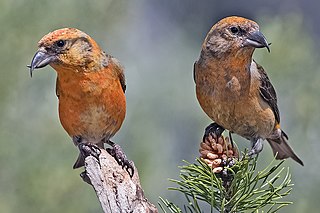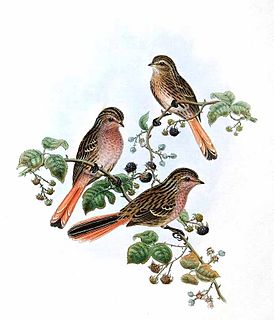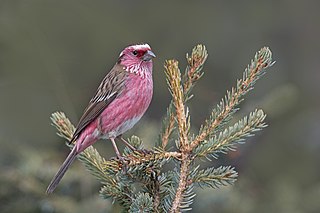
The true finches are small to medium-sized passerine birds in the family Fringillidae. Finches have stout conical bills adapted for eating seeds and nuts and often have colourful plumage. They occupy a great range of habitats where they are usually resident and do not migrate. They have a worldwide distribution except for Australia and the polar regions. The family Fringillidae contains more than two hundred species divided into fifty genera. It includes species known as siskins, canaries, redpolls, serins, grosbeaks and euphonias.

The rosefinches are a genus, Carpodacus, of passerine birds in the finch family Fringillidae. Most are called "rosefinches" and as the word implies, have various shades of red in their plumage. The common rosefinch is frequently called the "rosefinch". The genus name is from Ancient Greek karpos, "fruit" and dakno, "to bite".

The common rosefinch or scarlet rosefinch is the most widespread and common rosefinch of Asia and Europe.

The mountain finches are birds in the genus Leucosticte from the true finch family, Fringillidae. This genus also includes the rosy finches, named from their pinkish plumage.

The flora and fauna of Ladakh was first studied by Ferdinand Stoliczka, an Austrian Czech palaeontologist, who carried out a massive expedition in the region in the 1870s. The fauna of Ladakh have much in common with that of Central Asia generally, and especially those of the Tibetan Plateau. An exception to this are the birds, many of which migrate from the warmer parts of India to spend the summer in Ladakh. For such an arid area, Ladakh has a great diversity of birds — a total of 318 species have been recorded. Many of these birds reside or breed at high-altitude wetlands such as Tso Moriri.

The cardueline finches are a subfamily, Carduelinae, one of three subfamilies of the finch family Fringillidae, the others being the Fringillinae and the Euphoniinae. The Hawaiian honeycreepers are now included in this subfamily. Cardueline finches are specialised seed eaters, and unlike most passerine birds, they feed their young mostly on seeds, which are regurgitated. Besides this, they differ from the other finches in some minor details of their skull. They are adept at opening seeds and clinging to stems, unlike other granivorous birds, such as sparrows and buntings, which feed mostly on fallen seeds. Some members of this subfamily are further specialised to feed on a particular type of seed, such as cones, in the case of crossbills. Carduelines forage in flocks throughout the year, rather than keeping territories, and males defend their females rather than a territory or nest.

Przevalski's finch, Przewalski's finch or Przevalski's pinktail, is an unusual passerine bird endemic to the mountains of central-west China. The species is named for Nikolai Przhevalsky, the Russian explorer who described it. Its taxonomic affinities were unclear for a long time, giving rise to other common names, the pink-tailed bunting and the Przewalski's rosefinch. In 2000 it was proposed that it should in fact be regarded neither as a finch nor a bunting, but as the only member of the family Urocynchramidae, something that had been originally proposed in the German ornithological literature as long ago as 1918 by Janusz von Domaniewski, and also by Wolters in 1979. This change was adopted in the sixth edition of the Clements checklist.

The dark-breasted rosefinch is a true finch species.

The red-fronted rosefinch is a species of rosefinch in the finch family Fringillidae. It is sometimes placed in the monotypic genus Pyrrhospiza. It is found in Afghanistan, Bhutan, China, India, Kazakhstan, Nepal, Pakistan, Russia, Tajikistan, and Turkmenistan. Its natural habitat is montane tundra.
The Tibetan rosefinch, also known as Roborovski's rosefinch, is a species of rosefinch in the finch family Fringillidae. It is sometimes placed in the monotypic genus Kozlowia. It is endemic to the Tibetan Plateau. Its natural habitat is montane tundra.

The spot-winged rosefinch, also known as the spotted rosefinch, is a species of finch in the family Fringillidae. It is found in India and Nepal. Sharpe's rosefinch was formerly considered conspecific with it. Its natural habitat is subtropical or tropical high-altitude shrubland.

Pallas's rosefinch is a species of bird in the finch family Fringillidae. It is found in China, Japan, Kazakhstan, Korea, Mongolia, and Russia. Birds are occasionally reported from further west and there are records from several European regions, including Britain, but the cage-bird trade makes the origin of some such birds hard to assess. Its natural habitats are boreal forests and boreal shrubland.

Blanford's rosefinch or the crimson rosefinch, is a species of finch in the family Fringillidae. It is found in Bhutan, China, India, and Nepal. Its natural habitat is boreal forest.

The great rosefinch is a species of finch in the family Fringillidae. It is found in Afghanistan, Azerbaijan, Georgia, Kazakhstan, Kyrgyzstan, Mongolia, Pakistan, Russia, Tajikistan, and Uzbekistan and east to China. Its natural habitats are tundra and temperate grassland.

The streaked rosefinch is a true finch species. It is found on the Himalayan Plateau. Its natural habitat is boreal shrubland.

The vinaceous rosefinch is a species of finch in the family Fringillidae.

Sillem's mountain finch or the tawny-headed mountain finch is a species of rosefinch in the finch family. It is found only in China and was only known from two specimens collected in 1929 from the Aksai Chin area of southern Xinjiang Autonomous Region. In 2012, the bird was photographed 1500 km from the original collection location. This species was originally placed in the genus Leucosticte but a phylogenetic study using mitochondrial DNA sequences published in 2016 found that Sillem's mountain finch was a sister species to the Tibetan rosefinch. The International Ornithological Committee therefore moved Sillem's mountain finch to the genus Carpodacus.

The long-tailed rosefinch is a species of finch of the family Fringillidae.

The Chinese white-browed rosefinch is a true finch species.

















